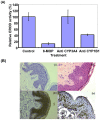Cytochrome P450 CYP1B1 interacts with 8-methoxypsoralen (8-MOP) and influences psoralen-ultraviolet A (PUVA) sensitivity
- PMID: 24086543
- PMCID: PMC3781062
- DOI: 10.1371/journal.pone.0075494
Cytochrome P450 CYP1B1 interacts with 8-methoxypsoralen (8-MOP) and influences psoralen-ultraviolet A (PUVA) sensitivity
Abstract
Background: There are unpredictable inter-individual differences in sensitivity to psoralen-UVA (PUVA) photochemotherapy, used to treat skin diseases including psoriasis. Psoralens are metabolised by cytochrome P450 enzymes (P450), and we hypothesised that variability in cutaneous P450 expression may influence PUVA sensitivity. We previously showed that P450 CYP1B1 was abundantly expressed in human skin and regulated by PUVA, and described marked inter-individual differences in cutaneous CYP1B1 expression.
Objectives: We investigated whether CYP1B1 made a significant contribution to 8-methoxypsoralen (8-MOP) metabolism, and whether individuality in CYP1B1 activity influenced PUVA sensitivity.
Methods: We used E. coli membranes co-expressing various P450s and cytochrome P450 reductase (CPR) to study 8-MOP metabolism and cytotoxicity assays in CYP1B1-expressing mammalian cells to assess PUVA sensitivity.
Results: We showed that P450s CYP1A1, CYP1A2, CYP1B1, CYP2A6 and CYP2E1 influence 8-MOP metabolism. As CYP1B1 is the most abundant P450 in human skin, we further demonstrated that: (i) CYP1B1 interacts with 8-MOP (ii) metabolism of the CYP1B1 substrates 7-ethoxyresorufin and 17-β-estradiol showed concentration-dependent inhibition by 8-MOP and (iii) inhibition of 7-ethoxyresorufin metabolism by 8-MOP was influenced by CYP1B1 genotype. The influence of CYP1B1 on PUVA cytotoxicity was further investigated in a Chinese hamster ovary cell line, stably expressing CYP1B1 and CPR, which was more sensitive to PUVA than control cells, suggesting that CYP1B1 metabolises 8-MOP to a more phototoxic metabolite(s).
Conclusion: Our data therefore suggest that CYP1B1 significantly contributes to cutaneous 8-MOP metabolism, and that individuality in CYP1B1 expression may influence PUVA sensitivity.
Conflict of interest statement
Figures



References
-
- Norris PG, Hawk JLM, Baker C, Bilsland D, Diffey BL, et al. (1994) British Photodermatology Group Guidelines for PUVA. British Journal of Dermatology 130: 246–255. - PubMed
-
- Patel RV, Clark LN, Lebwohl M, Weinberg JM (2009) Treatments for psoriasis and the risk of malignancy. Journal of the American Academy of Dermatology 60: 1001–1017. - PubMed
-
- Inzinger M, Heschl B, Weger W, Hofer A, Legat FJ, et al. (2011) Efficacy of psoralen plus ultraviolet A therapy vs. biologics in moderate to severe chronic plaque psoriasis: retrospective data analysis of a patient registry. British Journal of Dermatology 165: 640–645. - PubMed
-
- Stern RS, Laird N (1994) The Carcinogenic Risk of Treatments for Severe Psoriasis. Cancer 73: 2759–2764. - PubMed
-
- Ibbotson SH, Dawe RS, Dinkova-Kostova AT, Weidlich S, Farr PM, et al. (2012) Glutathione S-transferases genotype is associated with sensitivity to psoralen-ultraviolet A photochemotherapy. British Journal of Dermatology 166: 380–388. - PubMed
Publication types
MeSH terms
Substances
Grants and funding
LinkOut - more resources
Full Text Sources
Other Literature Sources
Research Materials

